Critical Literature Review of Cognitive Radio Networks Research
VerifiedAdded on 2023/06/15
|20
|4896
|497
Literature Review
AI Summary
This document presents a literature review of cognitive radio networks (CRNs), beginning with an introduction to the technology and its applications. It synthesizes existing research on the deployment status of CRNs, highlighting the benefits of CRNs over autonomous cognitive radios, such as improved spectrum sensing and coverage. The review critically examines the literature, discussing key issues like dynamic spectrum access (DSA), interference mitigation, and spectrum occupancy prediction. The document references xMax cognitive radios as an example of advanced CR technology. The review concludes by summarizing the research, identifying open research challenges, and discussing potential future directions in the field of cognitive radio networks. Desklib is a platform where you can find more such documents to help you with your studies.
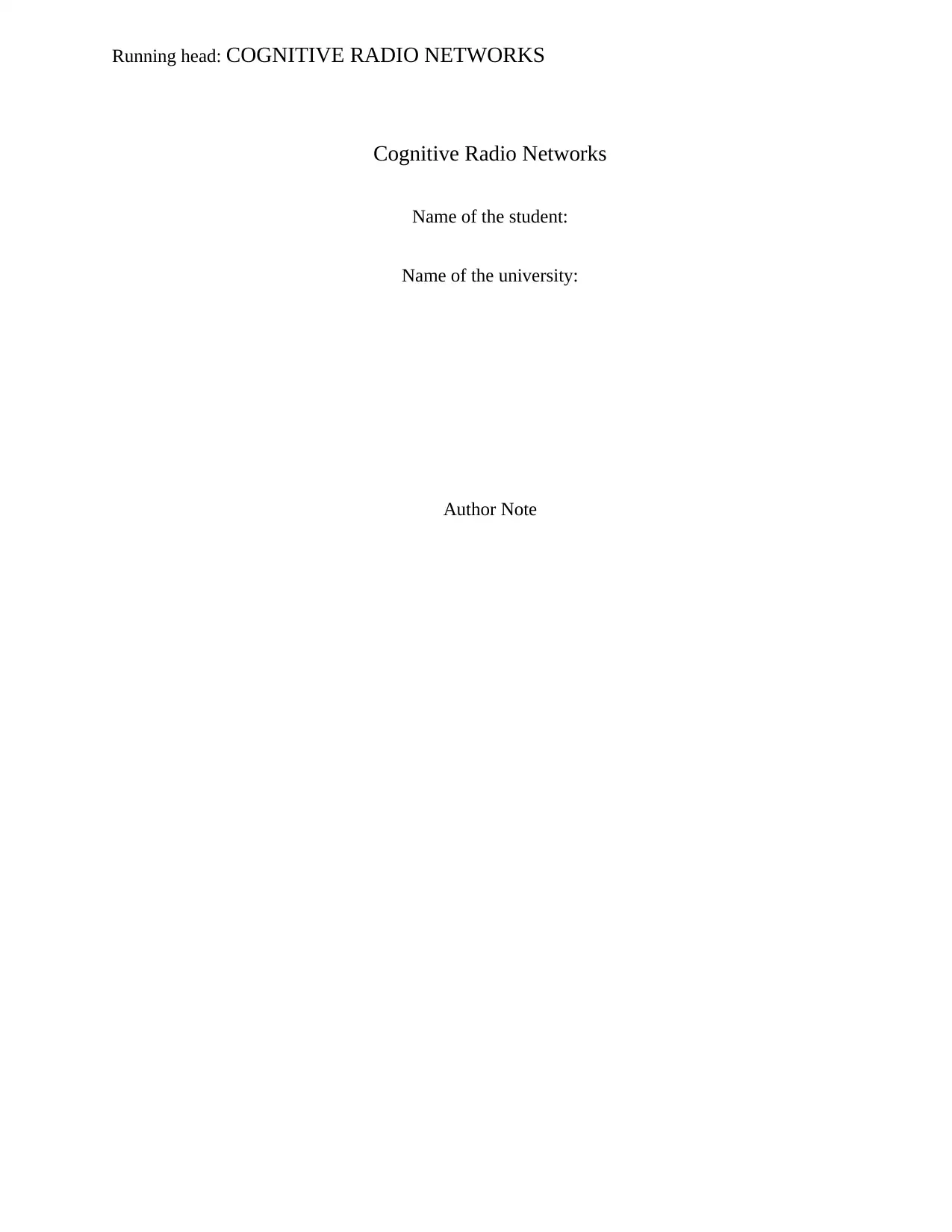
Running head: COGNITIVE RADIO NETWORKS
Cognitive Radio Networks
Name of the student:
Name of the university:
Author Note
Cognitive Radio Networks
Name of the student:
Name of the university:
Author Note
Paraphrase This Document
Need a fresh take? Get an instant paraphrase of this document with our AI Paraphraser
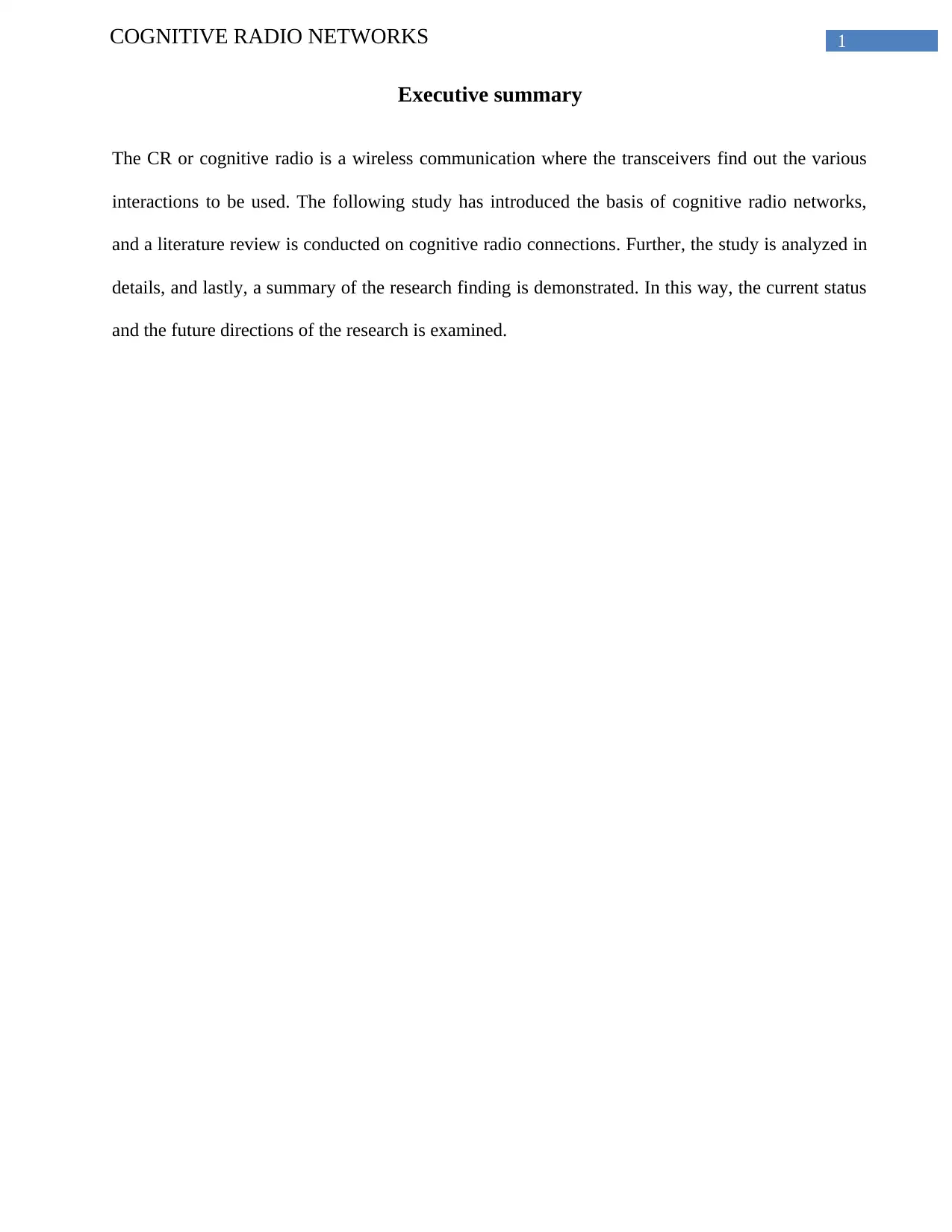
1COGNITIVE RADIO NETWORKS
Executive summary
The CR or cognitive radio is a wireless communication where the transceivers find out the various
interactions to be used. The following study has introduced the basis of cognitive radio networks,
and a literature review is conducted on cognitive radio connections. Further, the study is analyzed in
details, and lastly, a summary of the research finding is demonstrated. In this way, the current status
and the future directions of the research is examined.
Executive summary
The CR or cognitive radio is a wireless communication where the transceivers find out the various
interactions to be used. The following study has introduced the basis of cognitive radio networks,
and a literature review is conducted on cognitive radio connections. Further, the study is analyzed in
details, and lastly, a summary of the research finding is demonstrated. In this way, the current status
and the future directions of the research is examined.
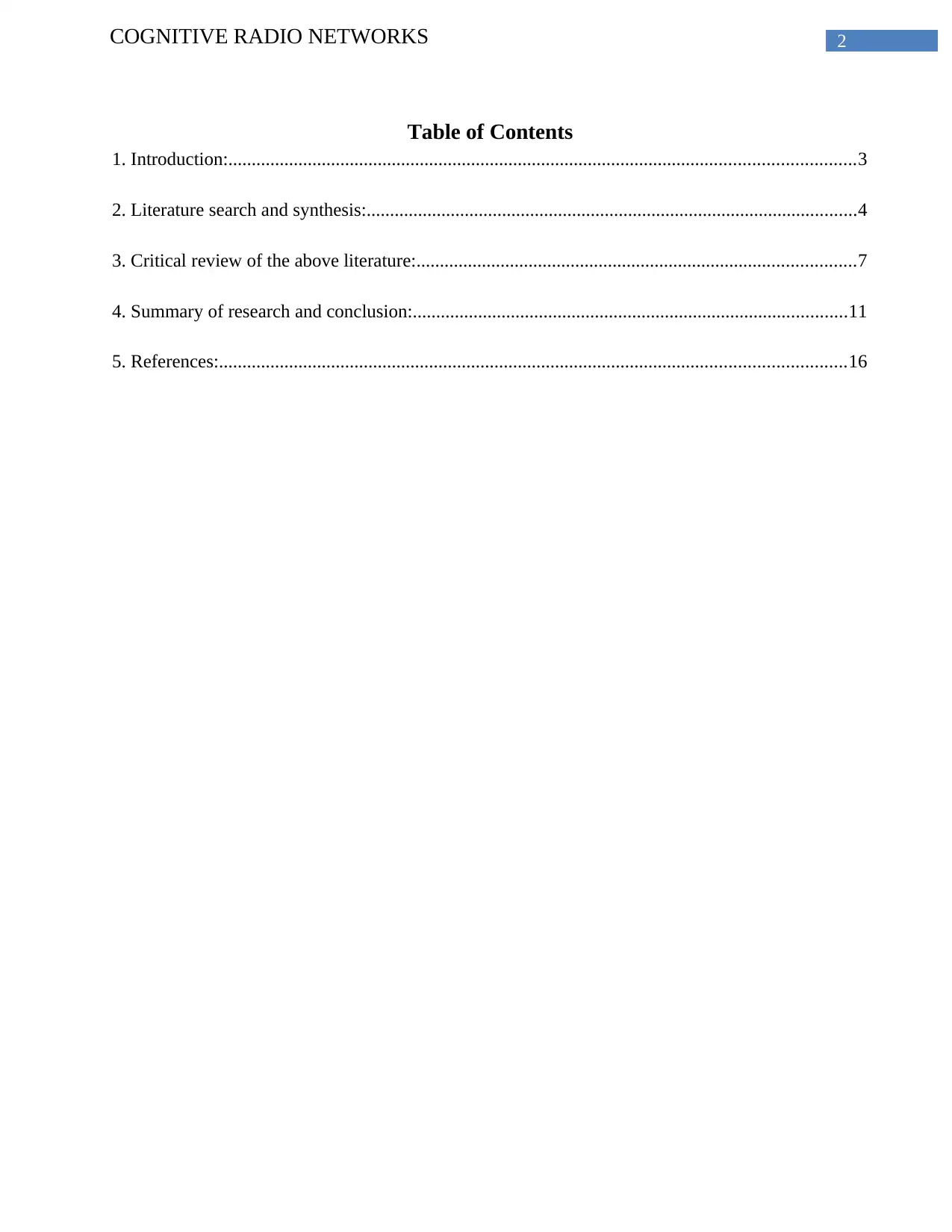
2COGNITIVE RADIO NETWORKS
Table of Contents
1. Introduction:......................................................................................................................................3
2. Literature search and synthesis:.........................................................................................................4
3. Critical review of the above literature:..............................................................................................7
4. Summary of research and conclusion:.............................................................................................11
5. References:......................................................................................................................................16
Table of Contents
1. Introduction:......................................................................................................................................3
2. Literature search and synthesis:.........................................................................................................4
3. Critical review of the above literature:..............................................................................................7
4. Summary of research and conclusion:.............................................................................................11
5. References:......................................................................................................................................16
⊘ This is a preview!⊘
Do you want full access?
Subscribe today to unlock all pages.

Trusted by 1+ million students worldwide

3COGNITIVE RADIO NETWORKS
1. Introduction:
The cognitive radio or CR is a kind of modern day wireless communications where
transceiver intelligently detects different communication channels that are to be used. It has been
optimizing the using of various kinds of available radio-frequency spectrums. These have been
minimizing the interference to multiple kinds of current users.
The CR in its primary form is a hybrid technology that has included SDR or “Software
Defined Radio”. This applies to spread various spectrum communications. Different possible
functions of CR involved a transceiver’s ability to find out the geographic location, recognize and
authorize the users, encrypt and then decrypt the signals (Li et al. 2016). Further, it has included a
sense of neighboring wireless devices in action. This has also added the adjusting of modulation
characteristics and output powers.
Moreover, there have been two primary kinds of cognitive radio. They are complete
cognitive radio and present day spectrum sensing cognitive radios. For instance, the full cognitive
radio considers every parameter that any wireless network or nodes are aware of. Again, on the other
hand, spectrum sensing cognitive radio is been effectively utilized in detecting various channels
within the radio frequency spectrum. The CR has been supporting the dynamic spectrum access.
This policy has been addressing issues with spectrum scarcity. This is encountered in various
countries. In this way, CR is broadly regarded as one of the outstanding and promising innovations
as far as future wireless communication is considered. In order to make wireless networks and radios
cognitive in real sense is not an easy job. However, this by no means has needed collaborative effort
from different research communities. This has included network engineering, signal processing,
software-hardware joint design, game theory, radio-frequency design and reconfigurable.
1. Introduction:
The cognitive radio or CR is a kind of modern day wireless communications where
transceiver intelligently detects different communication channels that are to be used. It has been
optimizing the using of various kinds of available radio-frequency spectrums. These have been
minimizing the interference to multiple kinds of current users.
The CR in its primary form is a hybrid technology that has included SDR or “Software
Defined Radio”. This applies to spread various spectrum communications. Different possible
functions of CR involved a transceiver’s ability to find out the geographic location, recognize and
authorize the users, encrypt and then decrypt the signals (Li et al. 2016). Further, it has included a
sense of neighboring wireless devices in action. This has also added the adjusting of modulation
characteristics and output powers.
Moreover, there have been two primary kinds of cognitive radio. They are complete
cognitive radio and present day spectrum sensing cognitive radios. For instance, the full cognitive
radio considers every parameter that any wireless network or nodes are aware of. Again, on the other
hand, spectrum sensing cognitive radio is been effectively utilized in detecting various channels
within the radio frequency spectrum. The CR has been supporting the dynamic spectrum access.
This policy has been addressing issues with spectrum scarcity. This is encountered in various
countries. In this way, CR is broadly regarded as one of the outstanding and promising innovations
as far as future wireless communication is considered. In order to make wireless networks and radios
cognitive in real sense is not an easy job. However, this by no means has needed collaborative effort
from different research communities. This has included network engineering, signal processing,
software-hardware joint design, game theory, radio-frequency design and reconfigurable.
Paraphrase This Document
Need a fresh take? Get an instant paraphrase of this document with our AI Paraphraser
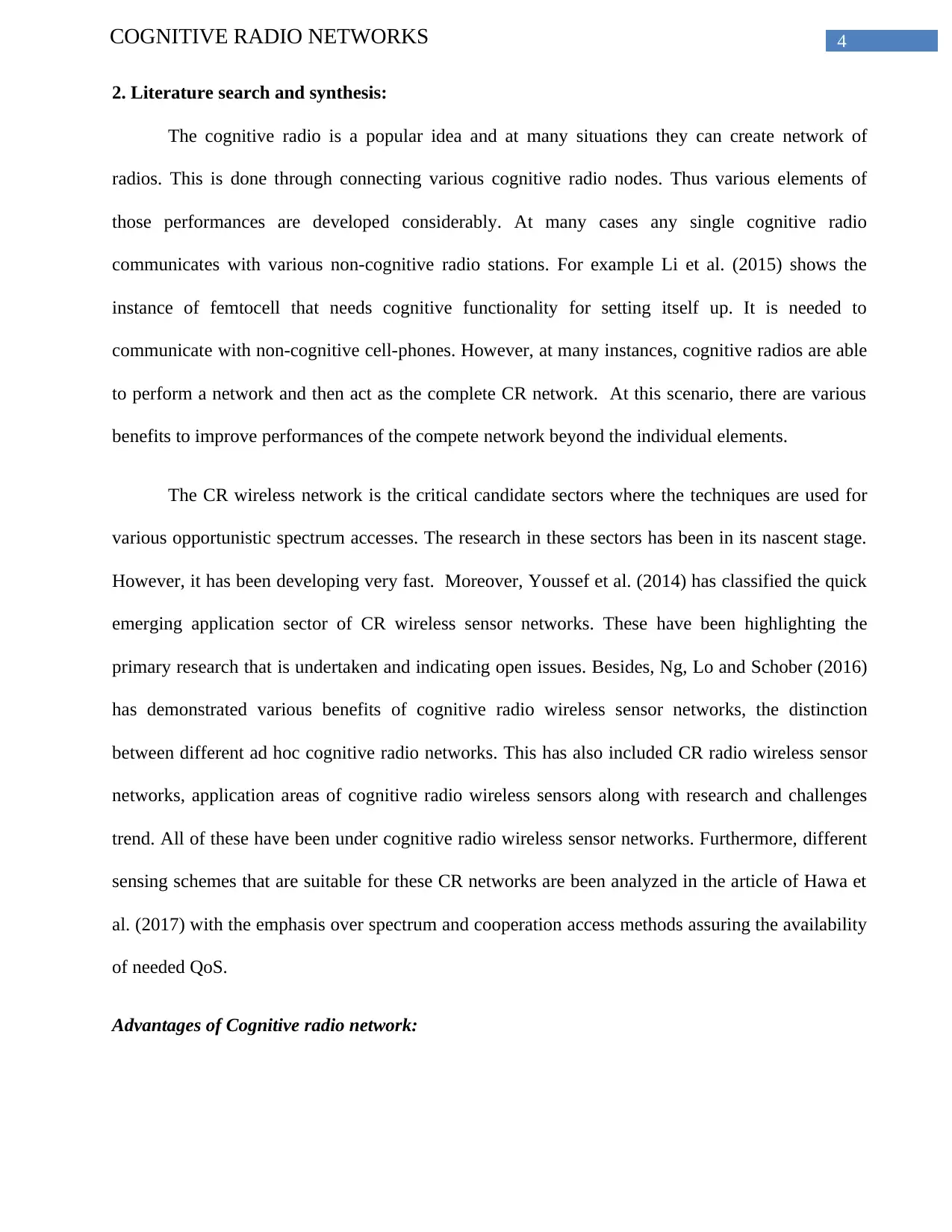
4COGNITIVE RADIO NETWORKS
2. Literature search and synthesis:
The cognitive radio is a popular idea and at many situations they can create network of
radios. This is done through connecting various cognitive radio nodes. Thus various elements of
those performances are developed considerably. At many cases any single cognitive radio
communicates with various non-cognitive radio stations. For example Li et al. (2015) shows the
instance of femtocell that needs cognitive functionality for setting itself up. It is needed to
communicate with non-cognitive cell-phones. However, at many instances, cognitive radios are able
to perform a network and then act as the complete CR network. At this scenario, there are various
benefits to improve performances of the compete network beyond the individual elements.
The CR wireless network is the critical candidate sectors where the techniques are used for
various opportunistic spectrum accesses. The research in these sectors has been in its nascent stage.
However, it has been developing very fast. Moreover, Youssef et al. (2014) has classified the quick
emerging application sector of CR wireless sensor networks. These have been highlighting the
primary research that is undertaken and indicating open issues. Besides, Ng, Lo and Schober (2016)
has demonstrated various benefits of cognitive radio wireless sensor networks, the distinction
between different ad hoc cognitive radio networks. This has also included CR radio wireless sensor
networks, application areas of cognitive radio wireless sensors along with research and challenges
trend. All of these have been under cognitive radio wireless sensor networks. Furthermore, different
sensing schemes that are suitable for these CR networks are been analyzed in the article of Hawa et
al. (2017) with the emphasis over spectrum and cooperation access methods assuring the availability
of needed QoS.
Advantages of Cognitive radio network:
2. Literature search and synthesis:
The cognitive radio is a popular idea and at many situations they can create network of
radios. This is done through connecting various cognitive radio nodes. Thus various elements of
those performances are developed considerably. At many cases any single cognitive radio
communicates with various non-cognitive radio stations. For example Li et al. (2015) shows the
instance of femtocell that needs cognitive functionality for setting itself up. It is needed to
communicate with non-cognitive cell-phones. However, at many instances, cognitive radios are able
to perform a network and then act as the complete CR network. At this scenario, there are various
benefits to improve performances of the compete network beyond the individual elements.
The CR wireless network is the critical candidate sectors where the techniques are used for
various opportunistic spectrum accesses. The research in these sectors has been in its nascent stage.
However, it has been developing very fast. Moreover, Youssef et al. (2014) has classified the quick
emerging application sector of CR wireless sensor networks. These have been highlighting the
primary research that is undertaken and indicating open issues. Besides, Ng, Lo and Schober (2016)
has demonstrated various benefits of cognitive radio wireless sensor networks, the distinction
between different ad hoc cognitive radio networks. This has also included CR radio wireless sensor
networks, application areas of cognitive radio wireless sensors along with research and challenges
trend. All of these have been under cognitive radio wireless sensor networks. Furthermore, different
sensing schemes that are suitable for these CR networks are been analyzed in the article of Hawa et
al. (2017) with the emphasis over spectrum and cooperation access methods assuring the availability
of needed QoS.
Advantages of Cognitive radio network:
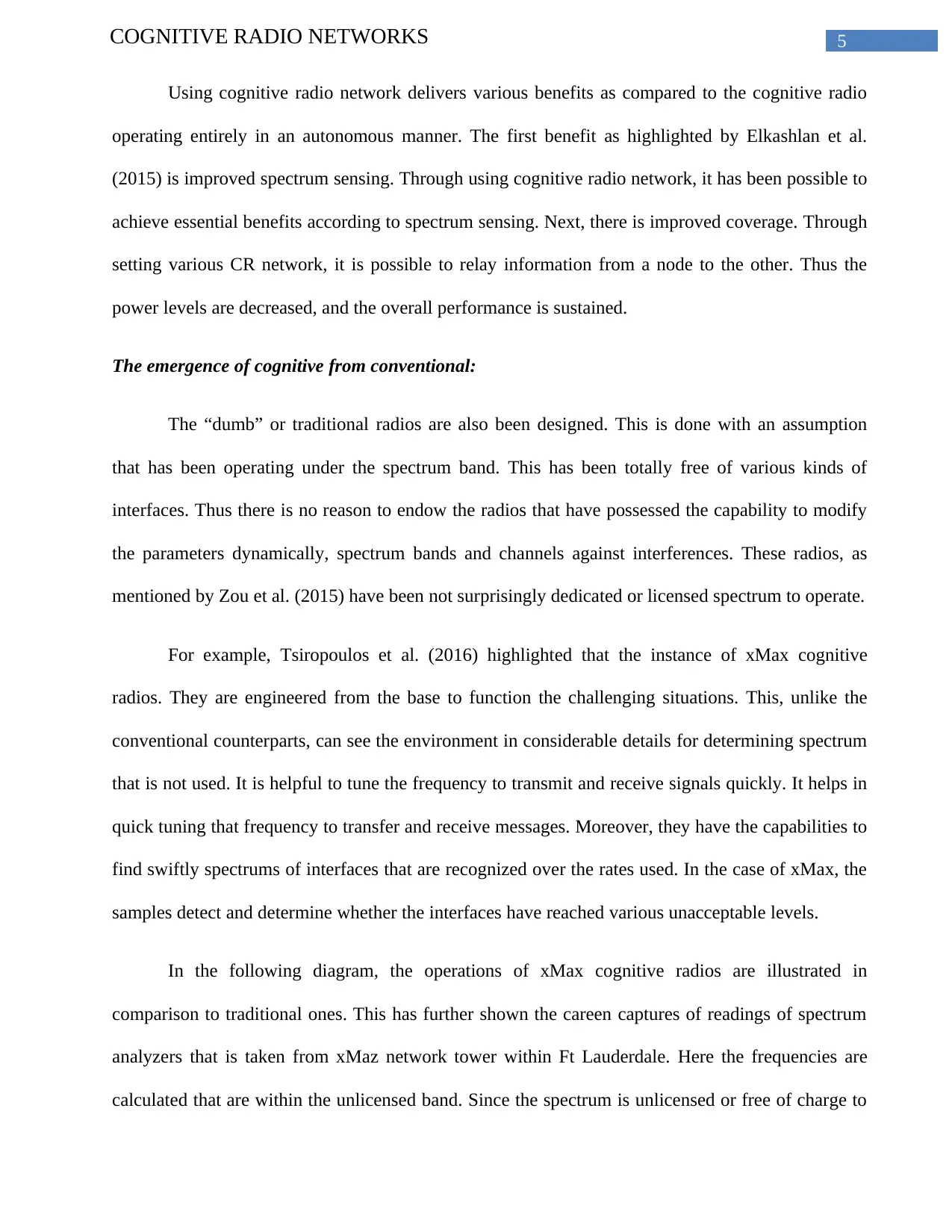
5COGNITIVE RADIO NETWORKS
Using cognitive radio network delivers various benefits as compared to the cognitive radio
operating entirely in an autonomous manner. The first benefit as highlighted by Elkashlan et al.
(2015) is improved spectrum sensing. Through using cognitive radio network, it has been possible to
achieve essential benefits according to spectrum sensing. Next, there is improved coverage. Through
setting various CR network, it is possible to relay information from a node to the other. Thus the
power levels are decreased, and the overall performance is sustained.
The emergence of cognitive from conventional:
The “dumb” or traditional radios are also been designed. This is done with an assumption
that has been operating under the spectrum band. This has been totally free of various kinds of
interfaces. Thus there is no reason to endow the radios that have possessed the capability to modify
the parameters dynamically, spectrum bands and channels against interferences. These radios, as
mentioned by Zou et al. (2015) have been not surprisingly dedicated or licensed spectrum to operate.
For example, Tsiropoulos et al. (2016) highlighted that the instance of xMax cognitive
radios. They are engineered from the base to function the challenging situations. This, unlike the
conventional counterparts, can see the environment in considerable details for determining spectrum
that is not used. It is helpful to tune the frequency to transmit and receive signals quickly. It helps in
quick tuning that frequency to transfer and receive messages. Moreover, they have the capabilities to
find swiftly spectrums of interfaces that are recognized over the rates used. In the case of xMax, the
samples detect and determine whether the interfaces have reached various unacceptable levels.
In the following diagram, the operations of xMax cognitive radios are illustrated in
comparison to traditional ones. This has further shown the careen captures of readings of spectrum
analyzers that is taken from xMaz network tower within Ft Lauderdale. Here the frequencies are
calculated that are within the unlicensed band. Since the spectrum is unlicensed or free of charge to
Using cognitive radio network delivers various benefits as compared to the cognitive radio
operating entirely in an autonomous manner. The first benefit as highlighted by Elkashlan et al.
(2015) is improved spectrum sensing. Through using cognitive radio network, it has been possible to
achieve essential benefits according to spectrum sensing. Next, there is improved coverage. Through
setting various CR network, it is possible to relay information from a node to the other. Thus the
power levels are decreased, and the overall performance is sustained.
The emergence of cognitive from conventional:
The “dumb” or traditional radios are also been designed. This is done with an assumption
that has been operating under the spectrum band. This has been totally free of various kinds of
interfaces. Thus there is no reason to endow the radios that have possessed the capability to modify
the parameters dynamically, spectrum bands and channels against interferences. These radios, as
mentioned by Zou et al. (2015) have been not surprisingly dedicated or licensed spectrum to operate.
For example, Tsiropoulos et al. (2016) highlighted that the instance of xMax cognitive
radios. They are engineered from the base to function the challenging situations. This, unlike the
conventional counterparts, can see the environment in considerable details for determining spectrum
that is not used. It is helpful to tune the frequency to transmit and receive signals quickly. It helps in
quick tuning that frequency to transfer and receive messages. Moreover, they have the capabilities to
find swiftly spectrums of interfaces that are recognized over the rates used. In the case of xMax, the
samples detect and determine whether the interfaces have reached various unacceptable levels.
In the following diagram, the operations of xMax cognitive radios are illustrated in
comparison to traditional ones. This has further shown the careen captures of readings of spectrum
analyzers that is taken from xMaz network tower within Ft Lauderdale. Here the frequencies are
calculated that are within the unlicensed band. Since the spectrum is unlicensed or free of charge to
⊘ This is a preview!⊘
Do you want full access?
Subscribe today to unlock all pages.

Trusted by 1+ million students worldwide
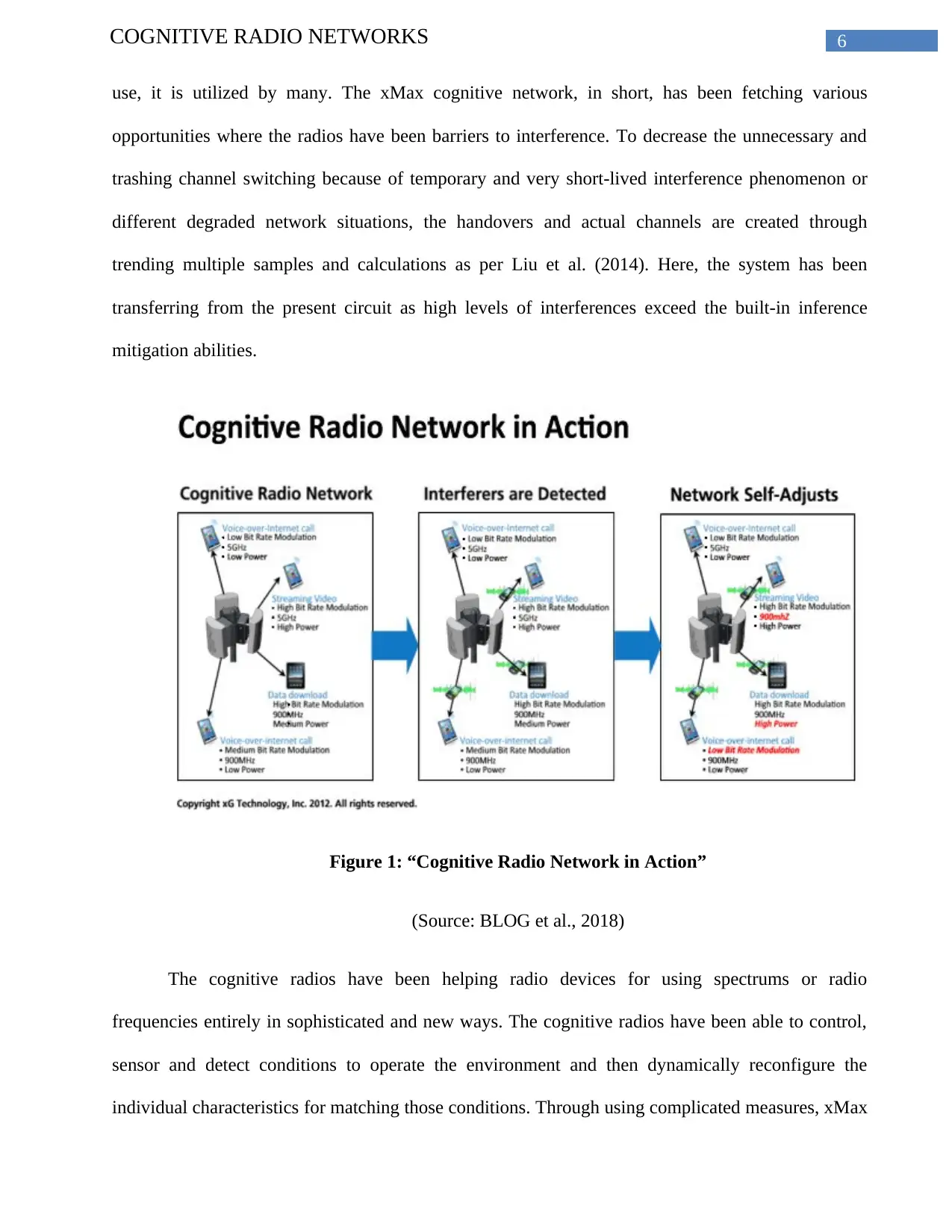
6COGNITIVE RADIO NETWORKS
use, it is utilized by many. The xMax cognitive network, in short, has been fetching various
opportunities where the radios have been barriers to interference. To decrease the unnecessary and
trashing channel switching because of temporary and very short-lived interference phenomenon or
different degraded network situations, the handovers and actual channels are created through
trending multiple samples and calculations as per Liu et al. (2014). Here, the system has been
transferring from the present circuit as high levels of interferences exceed the built-in inference
mitigation abilities.
Figure 1: “Cognitive Radio Network in Action”
(Source: BLOG et al., 2018)
The cognitive radios have been helping radio devices for using spectrums or radio
frequencies entirely in sophisticated and new ways. The cognitive radios have been able to control,
sensor and detect conditions to operate the environment and then dynamically reconfigure the
individual characteristics for matching those conditions. Through using complicated measures, xMax
use, it is utilized by many. The xMax cognitive network, in short, has been fetching various
opportunities where the radios have been barriers to interference. To decrease the unnecessary and
trashing channel switching because of temporary and very short-lived interference phenomenon or
different degraded network situations, the handovers and actual channels are created through
trending multiple samples and calculations as per Liu et al. (2014). Here, the system has been
transferring from the present circuit as high levels of interferences exceed the built-in inference
mitigation abilities.
Figure 1: “Cognitive Radio Network in Action”
(Source: BLOG et al., 2018)
The cognitive radios have been helping radio devices for using spectrums or radio
frequencies entirely in sophisticated and new ways. The cognitive radios have been able to control,
sensor and detect conditions to operate the environment and then dynamically reconfigure the
individual characteristics for matching those conditions. Through using complicated measures, xMax
Paraphrase This Document
Need a fresh take? Get an instant paraphrase of this document with our AI Paraphraser
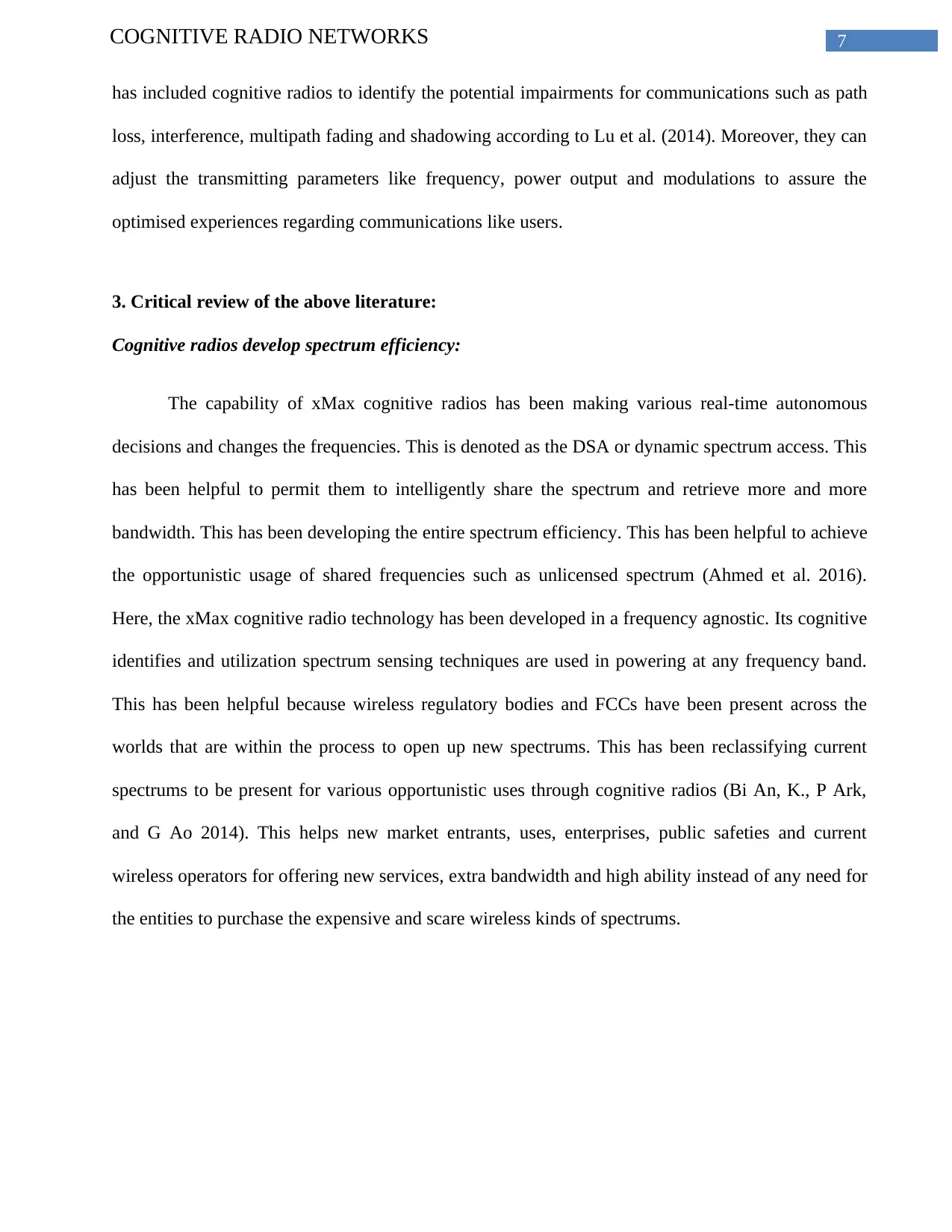
7COGNITIVE RADIO NETWORKS
has included cognitive radios to identify the potential impairments for communications such as path
loss, interference, multipath fading and shadowing according to Lu et al. (2014). Moreover, they can
adjust the transmitting parameters like frequency, power output and modulations to assure the
optimised experiences regarding communications like users.
3. Critical review of the above literature:
Cognitive radios develop spectrum efficiency:
The capability of xMax cognitive radios has been making various real-time autonomous
decisions and changes the frequencies. This is denoted as the DSA or dynamic spectrum access. This
has been helpful to permit them to intelligently share the spectrum and retrieve more and more
bandwidth. This has been developing the entire spectrum efficiency. This has been helpful to achieve
the opportunistic usage of shared frequencies such as unlicensed spectrum (Ahmed et al. 2016).
Here, the xMax cognitive radio technology has been developed in a frequency agnostic. Its cognitive
identifies and utilization spectrum sensing techniques are used in powering at any frequency band.
This has been helpful because wireless regulatory bodies and FCCs have been present across the
worlds that are within the process to open up new spectrums. This has been reclassifying current
spectrums to be present for various opportunistic uses through cognitive radios (Bi An, K., P Ark,
and G Ao 2014). This helps new market entrants, uses, enterprises, public safeties and current
wireless operators for offering new services, extra bandwidth and high ability instead of any need for
the entities to purchase the expensive and scare wireless kinds of spectrums.
has included cognitive radios to identify the potential impairments for communications such as path
loss, interference, multipath fading and shadowing according to Lu et al. (2014). Moreover, they can
adjust the transmitting parameters like frequency, power output and modulations to assure the
optimised experiences regarding communications like users.
3. Critical review of the above literature:
Cognitive radios develop spectrum efficiency:
The capability of xMax cognitive radios has been making various real-time autonomous
decisions and changes the frequencies. This is denoted as the DSA or dynamic spectrum access. This
has been helpful to permit them to intelligently share the spectrum and retrieve more and more
bandwidth. This has been developing the entire spectrum efficiency. This has been helpful to achieve
the opportunistic usage of shared frequencies such as unlicensed spectrum (Ahmed et al. 2016).
Here, the xMax cognitive radio technology has been developed in a frequency agnostic. Its cognitive
identifies and utilization spectrum sensing techniques are used in powering at any frequency band.
This has been helpful because wireless regulatory bodies and FCCs have been present across the
worlds that are within the process to open up new spectrums. This has been reclassifying current
spectrums to be present for various opportunistic uses through cognitive radios (Bi An, K., P Ark,
and G Ao 2014). This helps new market entrants, uses, enterprises, public safeties and current
wireless operators for offering new services, extra bandwidth and high ability instead of any need for
the entities to purchase the expensive and scare wireless kinds of spectrums.
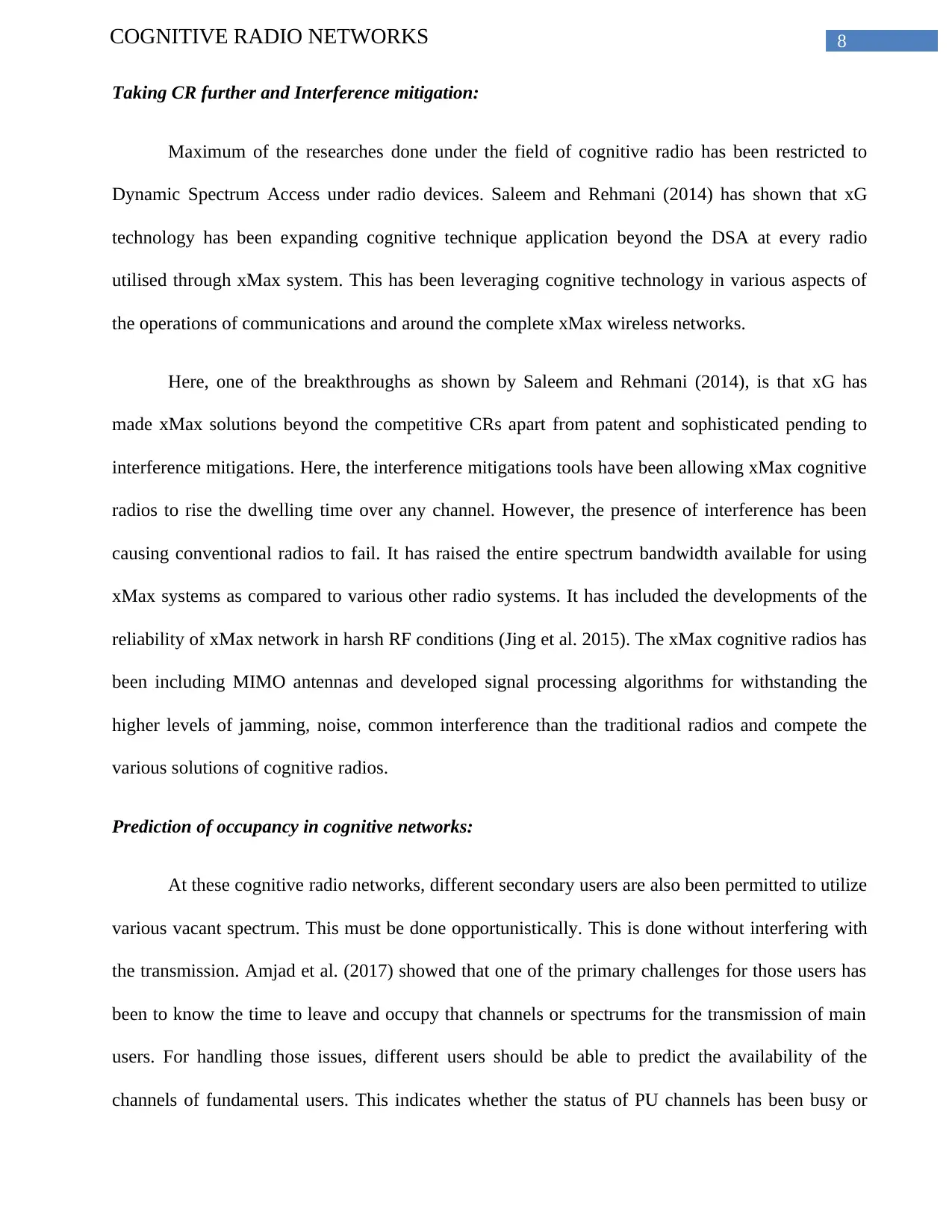
8COGNITIVE RADIO NETWORKS
Taking CR further and Interference mitigation:
Maximum of the researches done under the field of cognitive radio has been restricted to
Dynamic Spectrum Access under radio devices. Saleem and Rehmani (2014) has shown that xG
technology has been expanding cognitive technique application beyond the DSA at every radio
utilised through xMax system. This has been leveraging cognitive technology in various aspects of
the operations of communications and around the complete xMax wireless networks.
Here, one of the breakthroughs as shown by Saleem and Rehmani (2014), is that xG has
made xMax solutions beyond the competitive CRs apart from patent and sophisticated pending to
interference mitigations. Here, the interference mitigations tools have been allowing xMax cognitive
radios to rise the dwelling time over any channel. However, the presence of interference has been
causing conventional radios to fail. It has raised the entire spectrum bandwidth available for using
xMax systems as compared to various other radio systems. It has included the developments of the
reliability of xMax network in harsh RF conditions (Jing et al. 2015). The xMax cognitive radios has
been including MIMO antennas and developed signal processing algorithms for withstanding the
higher levels of jamming, noise, common interference than the traditional radios and compete the
various solutions of cognitive radios.
Prediction of occupancy in cognitive networks:
At these cognitive radio networks, different secondary users are also been permitted to utilize
various vacant spectrum. This must be done opportunistically. This is done without interfering with
the transmission. Amjad et al. (2017) showed that one of the primary challenges for those users has
been to know the time to leave and occupy that channels or spectrums for the transmission of main
users. For handling those issues, different users should be able to predict the availability of the
channels of fundamental users. This indicates whether the status of PU channels has been busy or
Taking CR further and Interference mitigation:
Maximum of the researches done under the field of cognitive radio has been restricted to
Dynamic Spectrum Access under radio devices. Saleem and Rehmani (2014) has shown that xG
technology has been expanding cognitive technique application beyond the DSA at every radio
utilised through xMax system. This has been leveraging cognitive technology in various aspects of
the operations of communications and around the complete xMax wireless networks.
Here, one of the breakthroughs as shown by Saleem and Rehmani (2014), is that xG has
made xMax solutions beyond the competitive CRs apart from patent and sophisticated pending to
interference mitigations. Here, the interference mitigations tools have been allowing xMax cognitive
radios to rise the dwelling time over any channel. However, the presence of interference has been
causing conventional radios to fail. It has raised the entire spectrum bandwidth available for using
xMax systems as compared to various other radio systems. It has included the developments of the
reliability of xMax network in harsh RF conditions (Jing et al. 2015). The xMax cognitive radios has
been including MIMO antennas and developed signal processing algorithms for withstanding the
higher levels of jamming, noise, common interference than the traditional radios and compete the
various solutions of cognitive radios.
Prediction of occupancy in cognitive networks:
At these cognitive radio networks, different secondary users are also been permitted to utilize
various vacant spectrum. This must be done opportunistically. This is done without interfering with
the transmission. Amjad et al. (2017) showed that one of the primary challenges for those users has
been to know the time to leave and occupy that channels or spectrums for the transmission of main
users. For handling those issues, different users should be able to predict the availability of the
channels of fundamental users. This indicates whether the status of PU channels has been busy or
⊘ This is a preview!⊘
Do you want full access?
Subscribe today to unlock all pages.

Trusted by 1+ million students worldwide
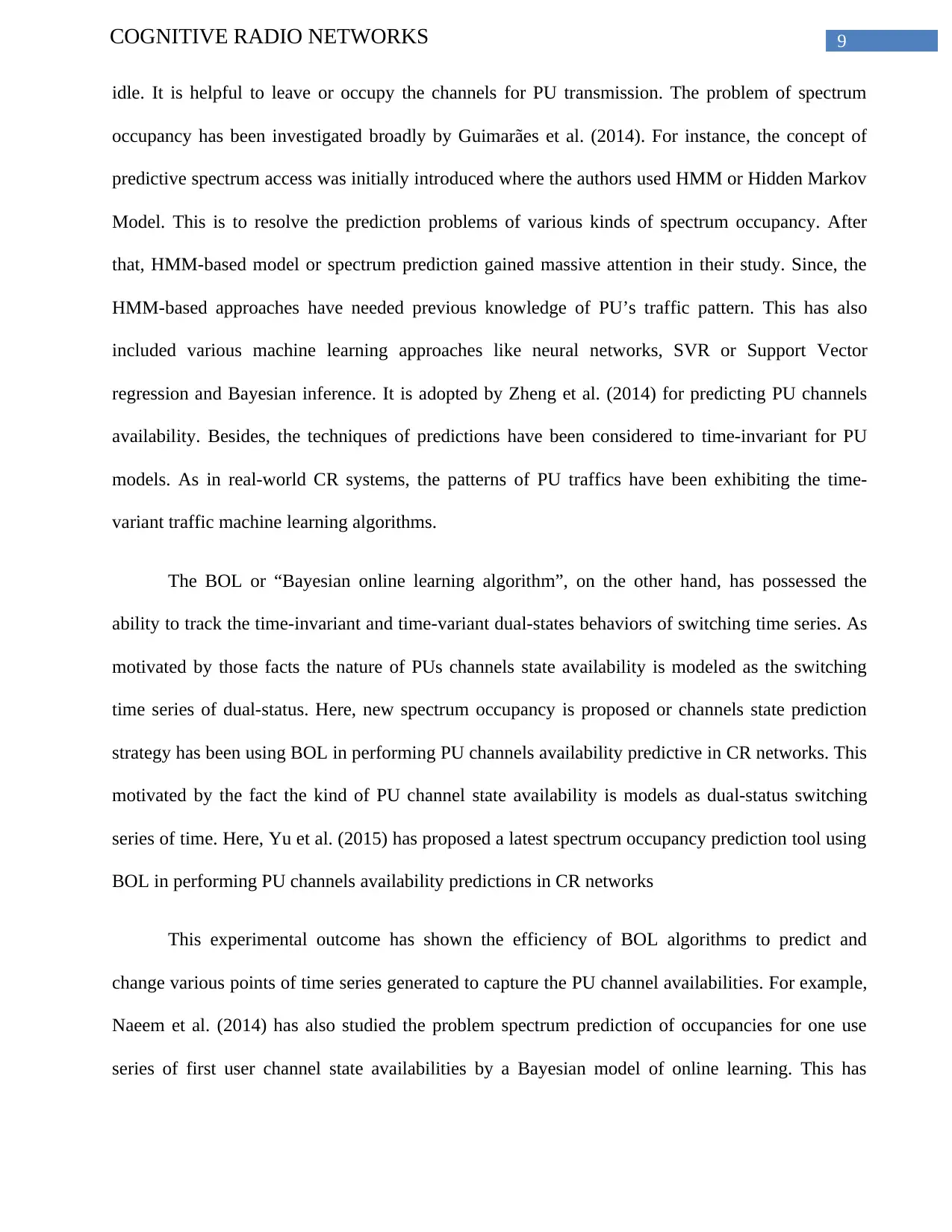
9COGNITIVE RADIO NETWORKS
idle. It is helpful to leave or occupy the channels for PU transmission. The problem of spectrum
occupancy has been investigated broadly by Guimarães et al. (2014). For instance, the concept of
predictive spectrum access was initially introduced where the authors used HMM or Hidden Markov
Model. This is to resolve the prediction problems of various kinds of spectrum occupancy. After
that, HMM-based model or spectrum prediction gained massive attention in their study. Since, the
HMM-based approaches have needed previous knowledge of PU’s traffic pattern. This has also
included various machine learning approaches like neural networks, SVR or Support Vector
regression and Bayesian inference. It is adopted by Zheng et al. (2014) for predicting PU channels
availability. Besides, the techniques of predictions have been considered to time-invariant for PU
models. As in real-world CR systems, the patterns of PU traffics have been exhibiting the time-
variant traffic machine learning algorithms.
The BOL or “Bayesian online learning algorithm”, on the other hand, has possessed the
ability to track the time-invariant and time-variant dual-states behaviors of switching time series. As
motivated by those facts the nature of PUs channels state availability is modeled as the switching
time series of dual-status. Here, new spectrum occupancy is proposed or channels state prediction
strategy has been using BOL in performing PU channels availability predictive in CR networks. This
motivated by the fact the kind of PU channel state availability is models as dual-status switching
series of time. Here, Yu et al. (2015) has proposed a latest spectrum occupancy prediction tool using
BOL in performing PU channels availability predictions in CR networks
This experimental outcome has shown the efficiency of BOL algorithms to predict and
change various points of time series generated to capture the PU channel availabilities. For example,
Naeem et al. (2014) has also studied the problem spectrum prediction of occupancies for one use
series of first user channel state availabilities by a Bayesian model of online learning. This has
idle. It is helpful to leave or occupy the channels for PU transmission. The problem of spectrum
occupancy has been investigated broadly by Guimarães et al. (2014). For instance, the concept of
predictive spectrum access was initially introduced where the authors used HMM or Hidden Markov
Model. This is to resolve the prediction problems of various kinds of spectrum occupancy. After
that, HMM-based model or spectrum prediction gained massive attention in their study. Since, the
HMM-based approaches have needed previous knowledge of PU’s traffic pattern. This has also
included various machine learning approaches like neural networks, SVR or Support Vector
regression and Bayesian inference. It is adopted by Zheng et al. (2014) for predicting PU channels
availability. Besides, the techniques of predictions have been considered to time-invariant for PU
models. As in real-world CR systems, the patterns of PU traffics have been exhibiting the time-
variant traffic machine learning algorithms.
The BOL or “Bayesian online learning algorithm”, on the other hand, has possessed the
ability to track the time-invariant and time-variant dual-states behaviors of switching time series. As
motivated by those facts the nature of PUs channels state availability is modeled as the switching
time series of dual-status. Here, new spectrum occupancy is proposed or channels state prediction
strategy has been using BOL in performing PU channels availability predictive in CR networks. This
motivated by the fact the kind of PU channel state availability is models as dual-status switching
series of time. Here, Yu et al. (2015) has proposed a latest spectrum occupancy prediction tool using
BOL in performing PU channels availability predictions in CR networks
This experimental outcome has shown the efficiency of BOL algorithms to predict and
change various points of time series generated to capture the PU channel availabilities. For example,
Naeem et al. (2014) has also studied the problem spectrum prediction of occupancies for one use
series of first user channel state availabilities by a Bayesian model of online learning. This has
Paraphrase This Document
Need a fresh take? Get an instant paraphrase of this document with our AI Paraphraser
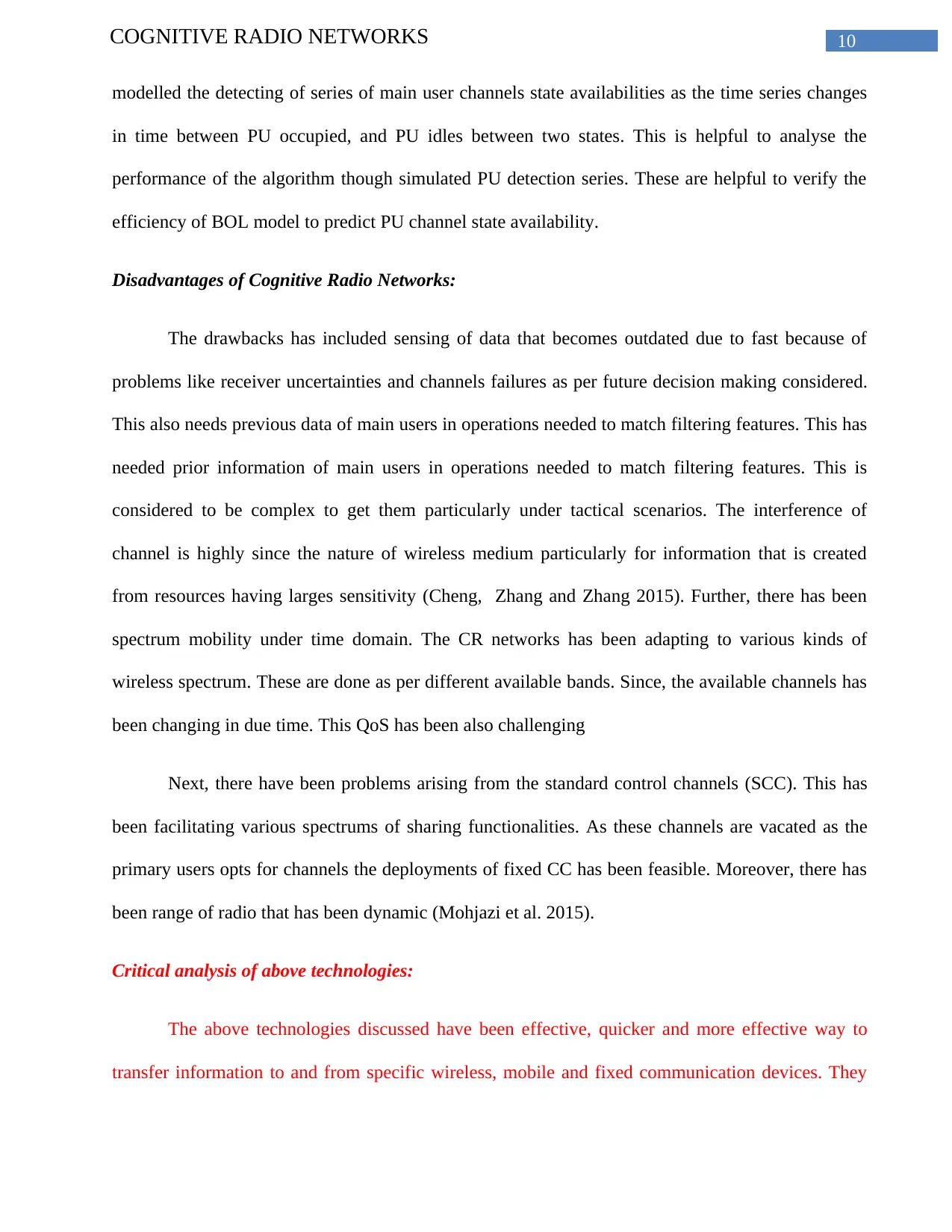
10COGNITIVE RADIO NETWORKS
modelled the detecting of series of main user channels state availabilities as the time series changes
in time between PU occupied, and PU idles between two states. This is helpful to analyse the
performance of the algorithm though simulated PU detection series. These are helpful to verify the
efficiency of BOL model to predict PU channel state availability.
Disadvantages of Cognitive Radio Networks:
The drawbacks has included sensing of data that becomes outdated due to fast because of
problems like receiver uncertainties and channels failures as per future decision making considered.
This also needs previous data of main users in operations needed to match filtering features. This has
needed prior information of main users in operations needed to match filtering features. This is
considered to be complex to get them particularly under tactical scenarios. The interference of
channel is highly since the nature of wireless medium particularly for information that is created
from resources having larges sensitivity (Cheng, Zhang and Zhang 2015). Further, there has been
spectrum mobility under time domain. The CR networks has been adapting to various kinds of
wireless spectrum. These are done as per different available bands. Since, the available channels has
been changing in due time. This QoS has been also challenging
Next, there have been problems arising from the standard control channels (SCC). This has
been facilitating various spectrums of sharing functionalities. As these channels are vacated as the
primary users opts for channels the deployments of fixed CC has been feasible. Moreover, there has
been range of radio that has been dynamic (Mohjazi et al. 2015).
Critical analysis of above technologies:
The above technologies discussed have been effective, quicker and more effective way to
transfer information to and from specific wireless, mobile and fixed communication devices. They
modelled the detecting of series of main user channels state availabilities as the time series changes
in time between PU occupied, and PU idles between two states. This is helpful to analyse the
performance of the algorithm though simulated PU detection series. These are helpful to verify the
efficiency of BOL model to predict PU channel state availability.
Disadvantages of Cognitive Radio Networks:
The drawbacks has included sensing of data that becomes outdated due to fast because of
problems like receiver uncertainties and channels failures as per future decision making considered.
This also needs previous data of main users in operations needed to match filtering features. This has
needed prior information of main users in operations needed to match filtering features. This is
considered to be complex to get them particularly under tactical scenarios. The interference of
channel is highly since the nature of wireless medium particularly for information that is created
from resources having larges sensitivity (Cheng, Zhang and Zhang 2015). Further, there has been
spectrum mobility under time domain. The CR networks has been adapting to various kinds of
wireless spectrum. These are done as per different available bands. Since, the available channels has
been changing in due time. This QoS has been also challenging
Next, there have been problems arising from the standard control channels (SCC). This has
been facilitating various spectrums of sharing functionalities. As these channels are vacated as the
primary users opts for channels the deployments of fixed CC has been feasible. Moreover, there has
been range of radio that has been dynamic (Mohjazi et al. 2015).
Critical analysis of above technologies:
The above technologies discussed have been effective, quicker and more effective way to
transfer information to and from specific wireless, mobile and fixed communication devices. They
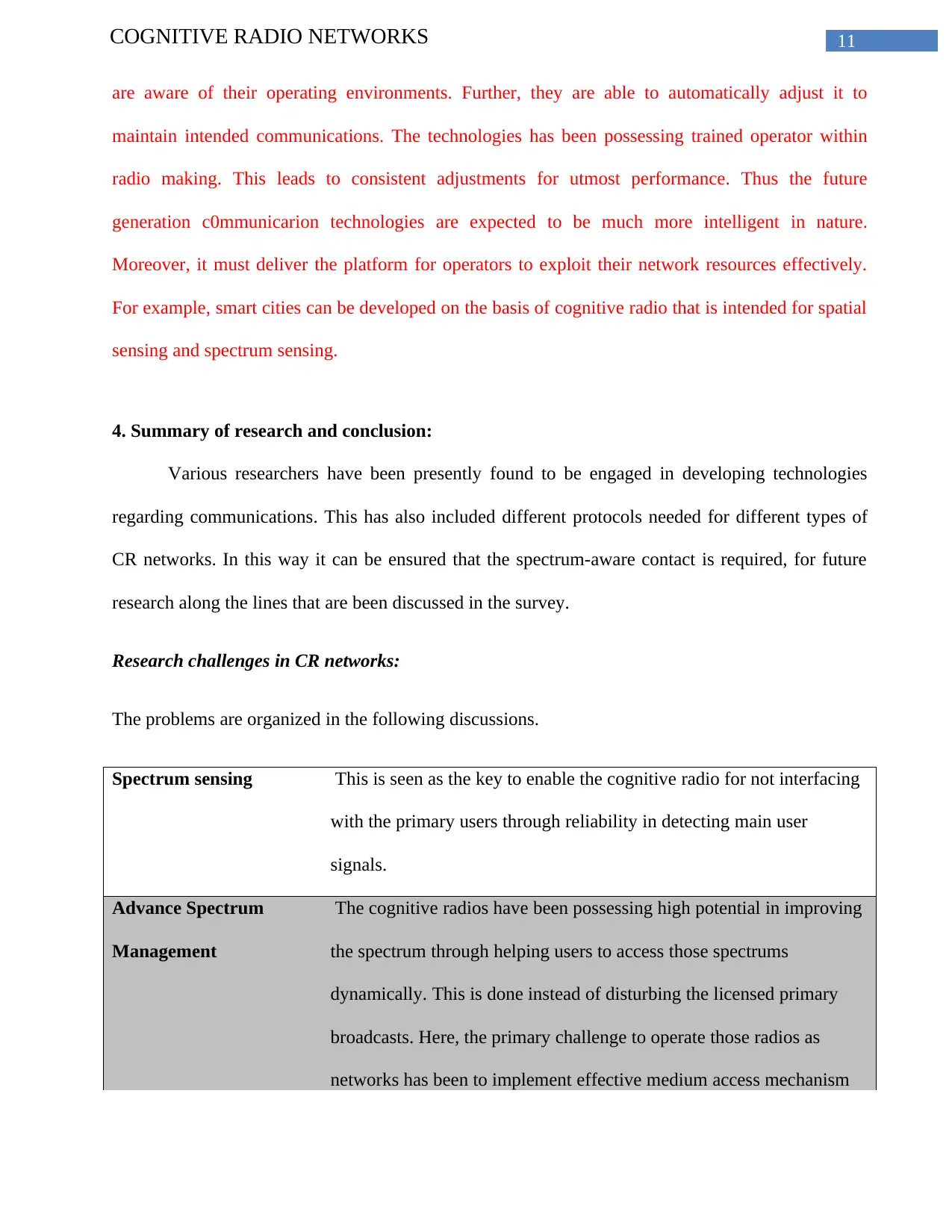
11COGNITIVE RADIO NETWORKS
are aware of their operating environments. Further, they are able to automatically adjust it to
maintain intended communications. The technologies has been possessing trained operator within
radio making. This leads to consistent adjustments for utmost performance. Thus the future
generation c0mmunicarion technologies are expected to be much more intelligent in nature.
Moreover, it must deliver the platform for operators to exploit their network resources effectively.
For example, smart cities can be developed on the basis of cognitive radio that is intended for spatial
sensing and spectrum sensing.
4. Summary of research and conclusion:
Various researchers have been presently found to be engaged in developing technologies
regarding communications. This has also included different protocols needed for different types of
CR networks. In this way it can be ensured that the spectrum-aware contact is required, for future
research along the lines that are been discussed in the survey.
Research challenges in CR networks:
The problems are organized in the following discussions.
Spectrum sensing This is seen as the key to enable the cognitive radio for not interfacing
with the primary users through reliability in detecting main user
signals.
Advance Spectrum
Management
The cognitive radios have been possessing high potential in improving
the spectrum through helping users to access those spectrums
dynamically. This is done instead of disturbing the licensed primary
broadcasts. Here, the primary challenge to operate those radios as
networks has been to implement effective medium access mechanism
are aware of their operating environments. Further, they are able to automatically adjust it to
maintain intended communications. The technologies has been possessing trained operator within
radio making. This leads to consistent adjustments for utmost performance. Thus the future
generation c0mmunicarion technologies are expected to be much more intelligent in nature.
Moreover, it must deliver the platform for operators to exploit their network resources effectively.
For example, smart cities can be developed on the basis of cognitive radio that is intended for spatial
sensing and spectrum sensing.
4. Summary of research and conclusion:
Various researchers have been presently found to be engaged in developing technologies
regarding communications. This has also included different protocols needed for different types of
CR networks. In this way it can be ensured that the spectrum-aware contact is required, for future
research along the lines that are been discussed in the survey.
Research challenges in CR networks:
The problems are organized in the following discussions.
Spectrum sensing This is seen as the key to enable the cognitive radio for not interfacing
with the primary users through reliability in detecting main user
signals.
Advance Spectrum
Management
The cognitive radios have been possessing high potential in improving
the spectrum through helping users to access those spectrums
dynamically. This is done instead of disturbing the licensed primary
broadcasts. Here, the primary challenge to operate those radios as
networks has been to implement effective medium access mechanism
⊘ This is a preview!⊘
Do you want full access?
Subscribe today to unlock all pages.

Trusted by 1+ million students worldwide
1 out of 20
Related Documents
Your All-in-One AI-Powered Toolkit for Academic Success.
+13062052269
info@desklib.com
Available 24*7 on WhatsApp / Email
![[object Object]](/_next/static/media/star-bottom.7253800d.svg)
Unlock your academic potential
Copyright © 2020–2025 A2Z Services. All Rights Reserved. Developed and managed by ZUCOL.





